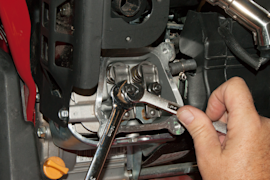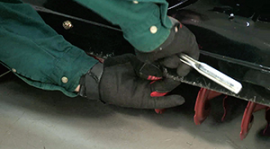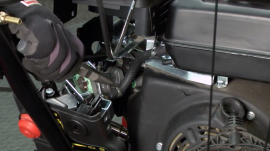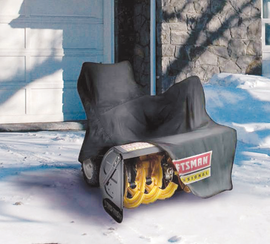Start-of-winter snowblower care


When the leaves start falling, haul out your snowblower and give it a once-over while you still have time to make repairs—before the first snowstorm hits.
Check out the rest of the snowblower articles and videos, as well as troubleshooting help and DIY repair guides.
Fuel up
Depending on what powers your snowblower, fueling up can be as easy as making sure the extension cord is in good shape or as complicated as mixing two-cycle oil with gas:
If you have a four-cycle gas-powered snowblower (and almost all are) and emptied it at the end of last winter, fill the gas tank with gasoline that's less than a month old. Don't fill the tank to the top—leave about 1/2 inch of space for the gas to expand as it warms up.
If you have a 2-cycle snowblower fueled by a gas/oil mix, add a mix of fresh, unleaded gasoline and fresh, clean two-cycle oil, usually in a 40:1 ratio (1 gallon of gas and 3.2 ounces of oil). Don't use boat or automotive oil. Don't use gas blended with ethanol or methanol, which become acidic and can damage your engine if left in the tank during storage.
If you have an electric snowblower, find the extension cord and replace it if it's damaged. To minimize energy loss between the outlet and the snow blower, the cord should be no more than 100 feet long.
Check for storage damage
Even though you put the machine away in good working order, bumps and thumps can happen in the shed during the summer. Work the chute to the left and right and, if it doesn't rotate fully, adjust the chute crank. Check the auger and discharge chute for errant tennis balls, chipmunk nests or other obstructions.
Lubricate
Check the owner's manual for lubrication points and apply the recommended grease.
Start it up
Move the machine outside and let it equilibrate with the outdoor temperature for 10 or 15 minutes. Then start the machine, listen for rattling or vibrating parts and tighten any loose fasteners.
Engage the auger and check whether it's turning. If it's not, the belt is damaged. Check the manual for instructions for replacing it. If you're uncomfortable handling this repair, take it to a service center.
Change the oil, filters and spark plug
To prolong the life of the engine, change the oil after each winter. Your owner's manual includes detailed instructions, but here's the basic procedure:
Warm up the engine for a few minutes so the oil will drain better and then remove the spark plug to prevent accidental starting.
Place a drain pan under the drain plug and remove the drain plug.
When the flow of oil stops, reinsert the drain plug.
Fill with the recommended oil, taking care not to overfill.
Replace or clean the air filter. Replace the fuel filter, if your machine has one.
Install a new spark plug. After removing the old plug and before inserting the new one, add a few drops of engine oil to the cylinder. While holding a rag over the spark plug hole to prevent spatters, pull the starter rope to spread the oil inside the cylinder.
Fill the tires
If your snow blower has pneumatic tires, check their pressure and fill as needed.
Symptoms for gas snowblowers
Choose a symptom to see related snowblower repairs.
Things to do: replace the spark plug, change the oil, rebuild the carburetor, adjust valve lash, adjust or replace the b…
Main causes: clogged chute, damaged auger blades, broken shear pins, worn auger belt, damaged gear case, engine problems…
Main causes: dirty carburetor, stale fuel…
Main causes: punctured tire, damaged rim…
Main causes: dirty carburetor, clogged fuel filter, dirty spark plug, incorrect valve lash, leaky engine gaskets…
Main causes: stale gas, clogged carburetor, clogged or broken fuel line, dirty spark plug, bad rewind starter, incorrect…
Main causes: loose drive clutch cable, damaged drive clutch cable, worn friction disc, scraper blade scraping the ground…
Main causes: snow build-up in chute, chute drive mechanism failure, bad chute control assembly…
Main causes: clogged chute, snow build-up in auger housing, broken auger shear pins, auger drive belt needs adjustment, …
Repair guides for gas snowblowers
These step-by-step repair guides will help you safely fix what’s broken on your snowblower.

How to adjust snowblower engine valve lash
Adjust the engine valve lash on your snowblower to keep the engine starting and running smoothly.…

How to adjust snowblower skid shoes
To prevent snowblower auger and shave plate damage, adjust the skid shoes regularly to keep the shave plate ¼-inch high.…

How to replace a snowblower shave plate
Follow the 7 easy steps in this repair guide/video to replace a worn out shave plate on your snowblower.…
Articles and videos for gas snowblowers
Use the advice and tips in these articles and videos to get the most out of your snowblower.

Get an overview of the main steps in a snowblower tune-up and click to videos with more details.…

Get your snowblower ready for winter before winter arrives, so you don't have to mess with it while snow piles up.…

Protect your snowblower's engine and body by preparing it for after-season storage.…